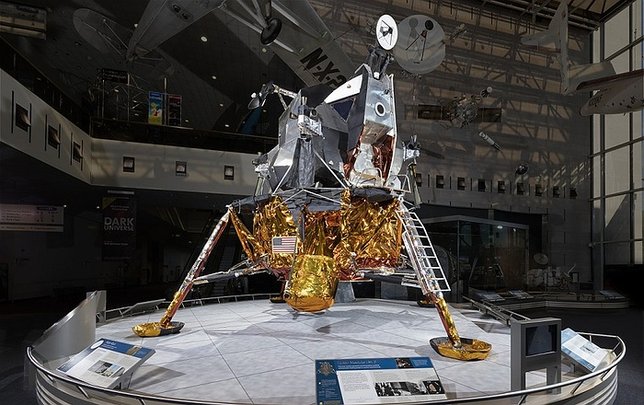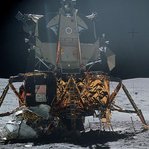During the Cold War, Russian launched the first artificial satellite called “Sputnik” and supercharged the space race. President John F. Kennedy promised we would put men on the moon by the end of the 1960s.
"I believe that this nation should commit itself to achieving the goal, before the decade is out, of landing a man on the moon and returning him safely to Earth," he said.
Spoiler alert: We did it.
The vehicle that carried us there was designed and built by Long Island-based Grumman Aerospace Corporation. Long Island is steeped in aerospace history and no accomplishment can rival the feat of rocketing humans to a heavenly body and back. (Read about five times Long Island made aviation history in our article here.)
Grumman was tasked with creating the vehicle that would take astronauts from the orbiting command module to the surface of the moon and back. It was known as the Lunar Module (affectionately called the “Lem.”)
See some historic pics of the Linar Lander here.
Below we present crazy and historical facts about the Grumman Lunar Module.
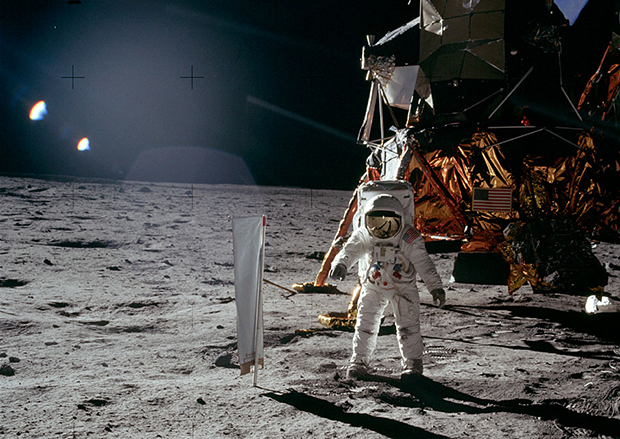
Photo: NASA.
History
-
In 1962, NASA invited 11 companies to submit proposals for a lunar excursion module
-
The proposal process was described by then vice president of Grumman Joseph G. Gavin Jr. as ”a game of Twenty Questions”
-
Grumman Aircraft was awarded the contract on November 7, 1962
-
All Lunar Modules were built on Long Island by Long Islanders
-
The vehicle is now officially known as the Lunar Module
-
It is affectionately known as the “Lem”
-
According to a NASA history document, the lunar module was called "lunar excursion module (LEM)" until 1966
-
It was renamed because the word "excursion" implied mobility on the moon and the vehicle did not have that capability
-
The name was shortened to Lunar Module and abbreviated LM but was still referred to as “Lem”
-
Later Apollo flights carried a lunar roving vehicle (LRV), aka "Rover" to provide greater mobility for the astronauts while on the surface of the moon
-
Thomas J. Kelly is credited as the Grumman engineer who led the team that designed and built the LM
-
Kelly was called the ''father of the lunar module'' by NASA
-
Kelly is quoted as saying, “Remember, there are six descent stages today sitting on the moon... with a ‘Made in Bethpage, New York’ nameplate on them. And that’s something that thousands of Grummanites take great pride in."
-
He wrote a book about it called “Moon Lander: How We Developed the Apollo Lunar Module”
-
The LM carried two crewmen to the lunar surface (while one stayed in orbit in the Command and Service Module aka CSM)
-
The LM was designed as a two-stage vehicle for space operations near and on the Moon
-
The stages were ascent and descent
-
Both stages were covered with gold, silver and black thermal shielding which gave the spacecraft a fragile appearance, according to the Cradle of Aviation Museum
-
No aerodynamic design was needed for the LM as it was intended to perform its mission strictly in the vacuum of space, making it the first true spacecraft
-
It was built of extremely light thin metal to conserve fuel while looking for a safe lunar landing spot during its mission
-
Its function was to support two astronauts on the moon and returned them to the CSM in lunar orbit
-
The LM was never flight tested because the lunar environment couldn’t be replicated, according to the Cradle of Aviation Museum
-
Grumman built a Lunar Module Simulator to train astronauts for lunar landings
-
The simulator operated at the Kennedy Space Center between 1968 and 1972 and was used by every Apollo astronaut to train for landing on the Moon prior to their mission
-
The LM simulator had an early virtual reality function to help simulate landing on the moon
-
Astronauts would sleep overnight inside it to prepare for three-day stays on the Moon
-
Only one was built and it survived to this day
-
The simulator is currently in the Cradle of Aviation Museum
-
The LM was used during the Apollo missions taking the first humans to the moon and back
-
NASA chose the name Apollo, because of the tradition of naming missions after Greek gods begun during the Mercury missions
-
Apollo was the god of archery, prophecy, poetry, and music, and most significantly he was god of the sun. In his horse-drawn golden chariot, Apollo pulled the sun in its course across the sky each day
-
In March 1969, the first crewed mission of the LM took place
-
In May 1962 the LM entered lunar orbit for the first time
-
The LM landed the first men on the moon during the Apollo 11 mission on July 20, 1969
-
It carried two astronauts, Commander Neil A. Armstrong and LM pilot Edwin E. "Buzz" Aldrin, Jr., the first men to walk on the Moon.
-
The LM is the only crewed vehicle to land anywhere other than Earth (that we know of)
-
About 22 hours later, Aldrin and Armstrong returned to the CSM for the crew’s return to Earth
-
Art on the Moon? It is rumored that artwork by Andy Warhol and other contemporary artists were etched onto a half-inch ceramic chip and covertly attached to the leg of a LM
-
The artwork still sits on the moon surface with the Intrepid LM, making it the one and only human art museum in outer space
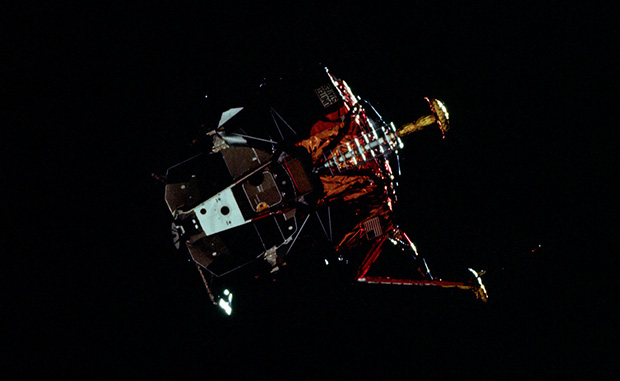
Photo: NASA.
LM Role in Coining Famous Phrases
-
The phrase “The Eagle has landed” used by people when arriving successfully or completing a mission originated when the Apollo 11 Lunar Module landed on the moon
-
Commander Armstrong set down on the lunar surface in the LM and announced, "Houston, Tranquility Base here - the Eagle has landed" (“Eagle” was the callsign of the LM for Apollo 11)
-
Commander Armstrong stepped out of the LM onto the lunar surface at around 11pm on July 20 EST and uttered his famous words, "That's one small step for man, one giant leap for mankind"
Stats
-
According to Apollo by the Numbers the lander was 31 feet wide by 23 feet high, weighing roughly between 32,000 and 36,000 lbs
-
It had a top speed of 17,500 mph
-
The LM computed and performed the lunar landing functions including abort, launch, and rendezvous and docking with Command and Service Module
-
Grumman built 13 LMs
-
Ten LMs were sent to space
-
Six LMs landed humans on the moon
-
Each Lunar Module had a distinct callsign for each Apollo mission
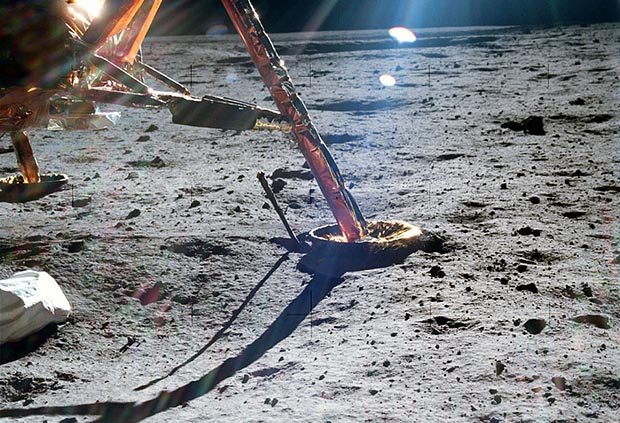
Photo: NASA.
LM Lifesaving Role in Apollo 13
-
As depicted in the famous movie, after the real Apollo 13 mission was aborted two days after launch when an explosion damaged the Service Module crewmen used the LM (named Aquarius) as a lifeboat to help return them to Earth
-
The LM - designed to support two astronauts for 45 hours - was used as a lifeboat to house the three astronauts (Commander James A. Lovell Jr., CSM pilot John L. Swigert Jr., and LM pilot Fred W. Haise Jr.) for 90 hours, as the CSM could not provide life support
-
Apollo 13 continued on to the Moon, and the LM descent engine was used to accelerate the spacecraft around the Moon and back to Earth
-
The LM was jettisoned shortly before reaching Earth, the astronauts returning to the Command Module for the reentry
-
Aquarius burned up in the Earth’s atmosphere with surviving pieces impacted in the ocean off the coast of New Zealand
Fate of the LMs
-
The crash sites of most LMs are known - but no-one is quite sure where the ascent stages of Apollo 11's module Eagle or Apollo 16's module Orion ended up
-
According to the Cradle of Aviation Museum, the 13th and final LM was never flown and is on permanent loan from the Smithsonian Institution to the Cradle of Aviation Museum on Charles Lindbergh Blvd in Garden City
-
There are two other LMs on display in U.S. museums, one at the Smithsonian's National Air and Space Museum in Washington, DC. and another at the Kennedy Space Center Visitor Complex in Florida
-
Two additional, partially built and unused LMs were scrapped by Grumman after the Apollo program was cancelled
-
According to NASA here is what happened to each of the Lunar Modules along with their callsigns and lunar landing sites:
|
Mission |
LM Callsign |
Lunar Landing Site |
Fate of Ascent Stage |
|
Apollo 5 |
Unnamed |
None |
Burned up in Earth's atmosphere |
|
Apollo 9 |
Spider |
None |
Burned up in Earth's atmosphere |
|
Snoopy |
Sea of Tranquillity |
In orbit around the sun |
|
|
Eagle |
Sea of Tranquillity |
Crash site unknown |
|
|
Intrepid |
Ocean of Storms |
Crash-landed on moon |
|
|
Aquarius |
Planned: Fra Mauro |
Used as a 'lifeboat' |
|
|
Antares |
Fra Mauro |
Crash-landed on moon |
|
|
Falcon |
HadleyApennine |
Crash landed on moon |
|
|
Orion |
Plain of Descartes |
Crash site unknown |
|
|
Challenger |
Taurus-Littrow |
Crash landed on moon |










